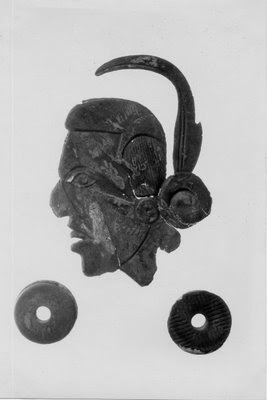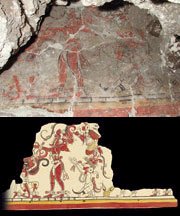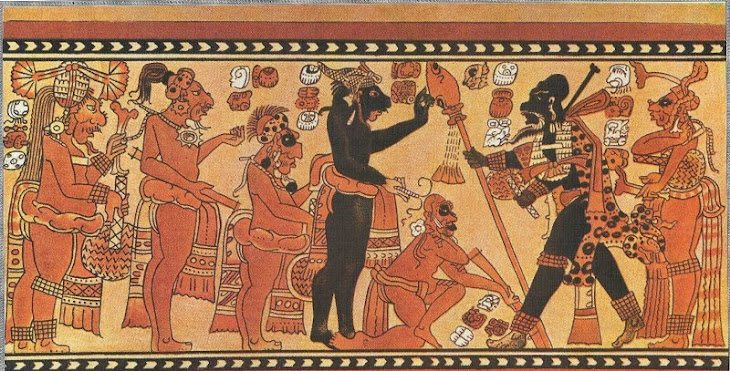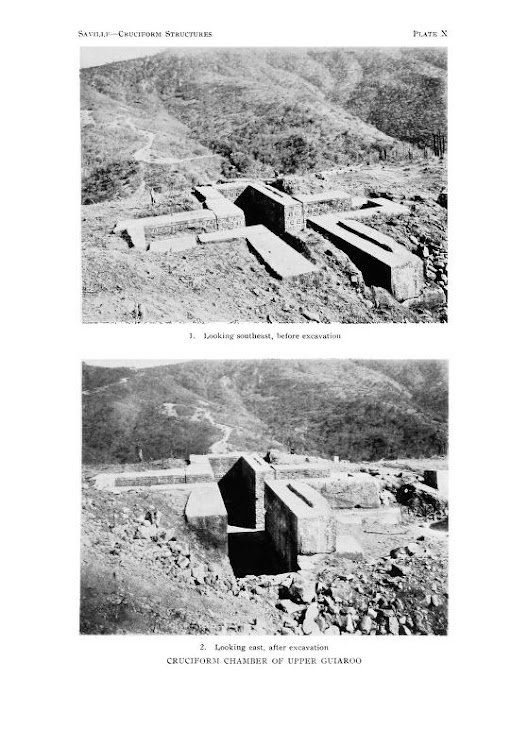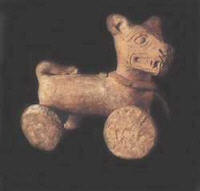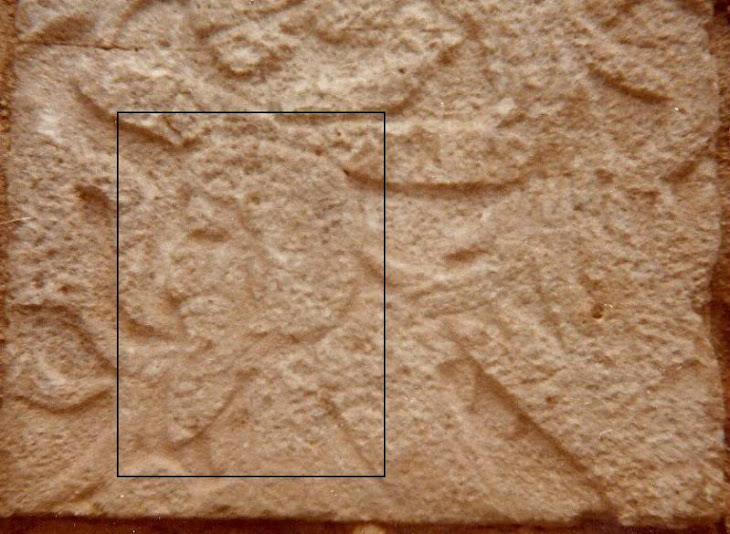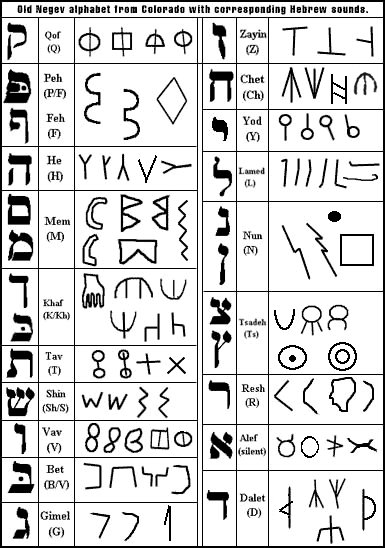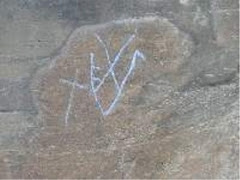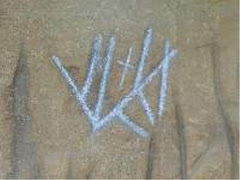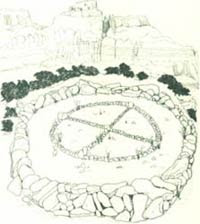Was ENGLISH Derived From HEBREW?
Was English derived from Hebrew? The idiomatic likenesses between ENGLISH and HEBREW were noticed by Tyndale when he translated the scriptures. He said, "The properties of the HEBREW tongue aggreeth a thousand times more with the ENGLISH than with the LATIN. The manner of speaking is in both one, so that, in a thousand places, there needest not but to translate the HEBREW word for word."
Canon Lyson found 5000 HEBREW ROOTS in the ENGLISH language (Our British Ancestors); other authorities put the figure still higher. The Welsh is so much like the Hebrew that the SAME SYNTAX may be used for both. The old SAXON language is said to be eighty percent HEBREW. The oldest poems in the CELTIC language are in the "Book of the Dun Cow" (1106 A.D.) and are "not unlike the poetical passages in the Old Testament" (5:626, Encyc. Brit. 11th).
Isaiah 28:11 says, "For with stammering lips and another tongue will he speak to this people" (Ephraim -- v.1). The Hebrew word for "stammering" here is "LAEG" reading right to left but English reads left to right so it would be pronounced GAEL in English. GAELIC is not only the foundation of the English language, but is still spoken in its primitive simplicity in many places in Wales, Scotland and the north of Ireland. God does speak to us through the English Bible (28:13).
Judges 12:6 says the Ephraimites had trouble pronouncing the aspirate "h" in Shibboleth. In Britain today, especially the Cockney, can't pronounce it either. You still hear, "Don't be so oggish with your horanges."
Speaking of the CELTIC use of the HEBREW rule of "ASPIRATION." Dr. Meyer says, "The assuming of the gutteral aspiration on the part of the consonant under the influence of the preceding vowel is the kind of change regularly adopted in IRISH, whereas in WELSH the vocalization of the mute is now the general rule. It is now unquestionable, however, from the gradual and even now only partial adoption of this rule in WELSH, that the IRISH usage is the MORE ANCIENT of the two, as is still further proved by its striking analogy with that of the DAGHESH LENE in HEBREW." Davidson's Hebrew Grammar says, "The word Daghesh is from a root which possibly expressed the idea of hardness. The sign of Daghesh is a point in the bosom of a letter, and this poiint was used to indicate both a lighter and a heavier kind of hardness.
When it indicates the lighter hardness it is called D. lene, when the stronger, it is called D. forte."
You can take any SENTENCE in HEBREW and change it into GAELIC, word for word, WITHOUT ALTERING the ORDER of a single word or particle, and you will have the correct GAELIC idiom in every case. You cannot do that with any other language in Europe. HEBREW has a rule which is known as "ASPIRATION." which applies to certain consonants when they follow a vowel. It means the same consonant has two different sounds, according to its position. GAELIC has the SAME rule and applies it in exactly the same way. Even words borrowed from other languages are at once modifies in sound according to the HEBREW rule of ASPIRATION. Does any other language use this rule? We don't know of any.
Ancient MEDIA,where the ten tribes were taken captive, is where the language of SANSKRIT developed. SANSKRIT has a more elaborate rule for modifying the consonants, called "SANDHI" under which every consonant may have as many as four distinct sounds, according to its position. Dr. Pritchard in his book The Eastern Origin of the Celtic Races has shown that WELSH alone of all living languages, has preserved the rule of SANDHI entire. He proves from this and many other similarities, including words in such common use as the whole paradigm of the verb "to be," that the ancestors of the WELSH must have lived among the people who spoke SANSKRIT. These people were ISRAELITES in MEDIA. He also shows that GOTHIC is the link between ancient SANSKRIT and modern TEUTONIC.
The grammatical structure of WELSH and HEBREW is the same. The VERB, for instance, occupies the SAME PLACE in the sentence of both languages. The ROOTS of most WELSH words may be traced to HEBREW. Not only do WELSH words themselves indicate a SIMILARITY; their VARIATIONS and INFLEXIONS afford a much stronger proof of affinity. In the CELTIC, as well as the HEBREW, the cases and gender of NOUNS are distinguished by AFFIXES and PREFIXES. The PLURAL number of nouns likewise is often formed in a similar manner in the CELTIC by adding "IN" to the singular. WELSH, like HEBREW, has NO PRESENT TENSE. In the formation of sentences, and in the government of words, in the AGREEMENT of the ADJECTIVE with the SUBSTANTIVE, in the precedence of the latter, in the usual EXCEPTIONS to this rule, and in VERBS PLURAL being GOVERNED by NOMINATIVES SINGULAR, the WELSH so exactly corresponds with the HEBREW that the SAME SYNTAX might serve for both. Meric Casaubon has taken some pains to show that the Saxon language has great affinity with the Greek (De Ling Sac. 234-376).
All our modern unabridged dictionaries are inadequate with regard to the origin or etymology of old ENGLISH words not derived from GREEK or LATIN. Very much of GREEK and LATIN and other European languages can be derived from HEBREW so the question becomes, "Did even those ENGLISH words that are similar to GREEK and LATIN come from them, or their predecessor HEBREW? These European languages are quite young compared with the old HEBREW. Pages 67 to 72 of God's Covenant Man British Israel gives many English roots from Hebrew.
The language of the learned bards, in which their poetry was conposed, was HEBREW. Taliesin, a celebrated bard of the ancient Britons, who was subsequently converted to Christianity, distinctly says, when speaking of his own songs, "My lore has been declared in HEBREW, in the HEBRAIC tongue have I sung." Dr. Thomas Stratton of Edinburgh said, "It would be difficult to adduce a single article or form of construction in the HEBREW grammar, but the same is to be found in WELSH, and there were many whole sentences in both languages exactly the same in the very words."
The HEBREW word for Festival is "MOED." The annual Scottish Gaelic musical festival is known as the "MOD." Another HEBREW word for Festival is "CHAG." The Scotch and Gaelic dance is called a "JIG." "HOORAY" or "HOORAH" comes from the HEBREW #7321 word for "shout" "ROOAH." CAIRN is the Irish pronunciation of the HEBREW QRN, meaning a "horn" which a CAIRN resembles in appearance. From this root the name of the Irish and Scottish hand-mill, the QUERN is derived; so called because the bottom stone is, at the top, in form of a horn on which the upper stone revolves. Professor Graves in 1855, speaking about an island at the mouth of the Kenmare River in Ireland, said that "The obvious and certain derivation of this name is Durs-ey, i.e. the 'Island of Dur,' DUR meaning water. The suffix "EY" meaning "island" in HEBREW is found in many names of British Islands such as Dalkey, Ireland's Eye, Lambay on the Irish coast, Anglesey, Orkney, Eday, Sanday, Bressay, Housay, Neay, Oxney (Isle of Oxen), Stokesay, Sheppey, Colonsay, Oronsay, Bardsey, Lundy, Guernsey, Jersey, Alderney, Menai and Thorney. Numbers 336 and 339 of Strong's give EE as the HEBREW sound for "island."Speaking before the British Association in 1847, James C. Pritchard, M.D., F.R.S. declared that Phoenician (HEBREW) writing was "the prototype of all the alphabets of ancient and modern Europe, and probably representing the form of letters in which the sacred Scriptures were originally written." He went on to say that languages constantly borrow words from other languages, but they seldom, if ever, borrow idioms. Consequently, idiomatic relationship is strong presumptive evidence of ethnological identity. J. W. Donaldson said in 1851 to the British Association: "Now modern philology leads us to the conclusion that the SEMITIC languages were originally built upon the same system of monosyllabic roots as the SANSCRIT and GREEK." ("British Association Reports," vol. 20, 1851, p.138 et seq.)
Notice the English "Rabbit" comes from the Hebrew "ARNBiT" (hare), the R and A reversed, the "Adder" from "ATaR" (to encircle), the "Kitten" from "QuiToN" (a little one), "Camel" from "GeMeL" (camel) and "Elephant" and "Antelope" from "ELePH" (ox). "Steer" from "SHOOR" (ox). "Giraffe" from "GaRaPH" (the neck), "Pig" from "PiGGuL" (abomination), "Snipe" from "INSOP" (water-fowl), the letters shuffled, "Dove" from "DOoB" (to murmur). "Sparrow" from "ZaPPOR" (sparrow). "Pelican" from "PeLeG" (a stream). "Raven" and "Robin" come from "OReB" (raven), "Crow" or "Rook" from "QRAW" (to call), "Egret" from "EGORT" (a crane), "Crane" from "GaRaN" (a throat), "Gull" from "GUL" (to move in a circuit), "Swallow" from "SaLO" (quail), "Osprey" from "PeRoS" (eagle), the S put in front, "Eagle" from "AKuL" (a devourer). "Fish" from "NePHeSH" (livingcreature), "Crab" from "AQRaB" (Scorpion), "Whelk" and "Leech," if we shuffle the letters, from "ELQ" (to adhere), "Haddock" from HaDDoQ" (a thorn), "Crayfish" from "ECVIS" (spider), "Wasp" from "AZB" (pain), "Moth" from "MOT" (little), "Worm" from "ORM" (naked). "Locust" from "LoQueSH" (to consume), "Gnat" from "NaD" (to fly), "Buzz" from "ZEBUB" (fly), "Shrub" from "ZhRuB" (to limit), "Berry" from "PeRi" (fruit in general), "Fruit" from "FRuCH" (to bud or blossom), "Branch" from "BRaCH" (to reach across), "Bark" from "BOOK" (to roll round), "Gum" from "GaM" (to join together), "Ash" from "AZH" (tree), "Elm" from "ALoN" (an oak), "Cypress" from "GOPHeR" (wood of Noah's ark), "Holly" from "HoLLeL"(pierces"), "Juniper" from "JuPeR" (sharp points), "Brush" from "BRuSH" (Fir), "Cedar" and "Citrus" and "Nectar" from QueTaR" (perfume), "Mistletoe" from "MaSL-TOH" (Lord of misrule). "Crocus" from "CRoCuM" (Saffron herb), "Nettle" from "NeTtO" (plant), "Squash" from "QuaSHA" (Cucumber), "Onion" from "OIN" (eye), "Cabbage" from "QaBaZH" (to gather together), "Turnip"and "Parsnip" from "NiB" (a plant), "Barley"from "BaR" (corn) plus "LaeH" (weary), "Lemon" and "Melon" from RIMMON (Pomegranate),"Peach" from "NePeCH" (citron) and "Raspberry" from "RaSP" (a red-hot coal). (For many more similarities, see English Derived From Hebrew by R. Govett and Our British Ancestors by Canon Lyson, as well as The Word by Prof. Isaac E. Mozeson. Photocopies of the first two works can be purchased from this website. Visit our "Old and Rare Religious Books" page.)
Why is Hebrew Read Right to Left?
Direction of writing HEBREW is RIGHT to LEFT while ENGLISH is LEFT to RIGHT. Therefore critics argue that the English couldn't be Israelites. But the Anglo-Saxon tongue was largely an UNWRITTEN one prior to their settlement in Britain. Speaking of the "Alphabet and its Origin" at a meeting of the British Association in 1872, John Evans, F.R.S., F.S.A. says, "If the date which has been assigned to the famous 'Moabite stone,' of about 900 B.C., be correct, the correspondence in form between the archaic GREEK letters and those on the stone raises a strong presumption in favor of letters having been imported into Greece at the time when the PHOENICIAN alphabet was in that stage of development in which it occurs on the stone. Even the name of the alphabet preserves the memory of its PHOENICIAN origin, for Alpha and Beta, the names of the two letters from which the word is derived, are not really GREEK, but merely the Hellenized form of the PHOENICIAN (i.e. HEBREW) Aleph and Beth. The same is the case with the namesof all the other GREEK letters down to Tau.... It must, however, be remembered, that the letters (of the Moabite Stone) are written from RIGHT to LEFT, or in the same manner as HEBREW, and not as is the case with us, from LEFT to RIGHT. In the early GREEK inscriptions it appears to have been a matter of INDIFFERENCE in which DIRECTION the letters were placed. In some the lines are alternately in EITHER DIRECTION; and this form of writing was known as Boustrophedon, or that which turned BACKWARDS and FORWARDS like an ox in ploughing.... The language of the HEBREW Scriptures may practically be regarded as the same as the PHOENICIAN" ("British Association Reports," 1872, Transactions, p.181 et seq.).
The Encyclopedia Britannica, 14th edition, vol.3, p.972, article "Boustro- phedon," says: "A term descriptive of a peculiar form of writing common among the early GREEKS. The direction of writing was alternately RIGHT to LEFT and LEFT to RIGHT in horizontal lines, or conversely, LEFT to RIGHT and RIGHT to LEFT. It was a transition between the earlier RIGHT to LEFT writing and the later LEFT to RIGHT style. The term was derived from two Greek words meaning "ox" and "to turn," from the resemblance of the writing to the winding course taken by oxen in ploughing."
Sir Charles Marston in The Bible Comes Alive says, "It will be seen, from the archaeological evidence cited in these pages, that the Israelites had, from the time of Moses onward, at least three alphabetical scripts. First, what is known as the SINAI HEBREW; next, what is known as PHOENICIAN HEBREW; and lastly, after the captivity in Babylon, what is known as the ASSYRIAN HEBREW." (p.8). "So far as is known at present, it would seem as though the SINAI HEBREW script usually reads from LEFT to RIGHT, like our own writing, while the PHOENICIAN HEBREW reads from RIGHT to LEFT, like modern Hebrew."
Professor Stephen Langdon, M.A., B.D., Ph.D., F.B.A., Professor of Assyriology at Oxford, wrote, in a letter to the "Times" on 5th October, 1935, with reference to the SINAI HEBREW inscription on the Lachish Red Bowl which had been published in that journal on 24th June, under the title "Antiquities from Lachish" by J.L. Starkey: "The inscription as published in the 'Times' should be INVERTED and read from LEFT to RIGHT; for this was the original direction of writing the SINAITIC script."
The Lacedemonians wrote GREEK from LEFT to RIGHT; yet they were Israelites (1 Maccabees 12:6-23).
Was RUNIC Derived From HEBREW?
The early Saxon alphabet contained letters before its contact with Greece or Rome. The old Runes are letters. The Saxons had terms of their own, not borrowed from Latin, for alphabetical letters. Writing is expressed in Saxon by a verb not of Roman origin. Saxons didn't derive their word for "book" from "liber." However there are numerous points of resemblance between the ancient British (or Runic) alphabet and those of the ancient Hebrews and Phoenicians (Haigh's Conquest of Britain By The Saxons, pp.33, 68, 88, 106, 107). The futhoric, or Runic alphabet, originated, "clearly in times of primitive antiquity. The nomenclature of the Phoenician-Hebrew alphabet is admitted to indicate its having originated in a primitive state of society, and that of the futhoric has precisely the SAME CHARACTER. Indeed it is remarkable how many of the objects named are COMMON to BOTH, how IDENTICAL was the feeling which dictated in each case the choice of the SYMBOLS.... the remarkable coincidence in both systems, commencing with the names of domestic cattle." One of the earliest of these futhorics consisted of SIXTEEN runes; so also did the early Phoenician. As in Phoenician and Hebrew, so on Runic monuments in Norway and Sweden, writing is found from was RIGHT to LEFT. In the symbols employed there are several parallels. "ALEPH, the first character of the Hebrew and Phoenician alphabet, was the head of an OX with its horns; FEOH, the first letter of the Runic, with the same meaning, is but a variant of the same symbol, and corresponds very nearly with the Samaritan character.... THORN, the third rune, is certainly allied to DALETH, and as the latter is a "DOOR," so we may regard the former (of which Thur is one of the variants) as thurn or durn, with the same signification. The Phoenician-Hebrew letters KOPH and RESCH symbolize and signify the "HEAD"; the Greek Rho is identical with the primitive Resch; the Latin R and the Runic RAED differ from it only in the addition of a beard; whilst the Runic WAEN, again, has the primitive form.... The Phoenician CHETH or HETH has sometimes exactly the form of the Anglo-Saxon HAEGEL; it means and represents an "ENCLOSURE" or "PARK" and it is very probable that HAEGEL means the same, for HAEGE is a "HEDGE" and HAEGIAN to "HEDGE" would admit of a derivative noun HAEGEL.... The Phoenician-Hebrew LAMED is a "WHIP," "ROD" or "GOAD"; the Runic LAGU has the form of a "WHIP," the symbol of authority in Egyptian hieroglyphics. Its meaning is "LAW." CALC has the form of a THUNDERBOLT which characterizes Nin in the Assyrian sculptures, and when his title "KHALK-halla, "brother of the lightning" and the name of his father's sacred city KALK-ha are considered, we must conclude that the word signified what the form of the character denotes. STAN has the form in which the Phoenicians cast their pigs of TIN, and is stamped as a symbol on one so formed, found in Cornwall, and now in Truro Museum; it is therefore extremely probable that the word, like the Latin STANNUM, means "TIN." Lastly, the Runic COPULATIVE sign has precisely the ancient form of VAU, which means a "HOOK," and as such became in Hebrew the COPULATIVE conjunction.
Thus we see that the PHOENICIAN alphabet and the Anglo-Saxon FUTHORIC are derived from a common source; that the same feeling dictated the choice of the symbols, which were to be used as letters in each case; and that each letter represents the initial sound of the name of the corresponding symbol. It must be remembered that the regular square Hebrew type was a comparatively LATE invention, and that the early PHOENICIAN-HEBREW forms were those familiar to the Israelites of the captivity of 721 B.C. Comparing HEBREW-PHOENICIAN with RUNIC suggests that RUNIC consisted of old HEBREW letters. There are many cases where the very SAME FORM is used for two different letters in Hebrew and Runic.
Isaac Taylor, in his work on the RUNIC characters accounts for the spread of RUNIC characters from the Black Sea to the Baltic by saying that the Goths were formerly Getae. The RUNIC came to the North from Asgard -- a place which Taylor identifies with the Gerrhos of Herodotus. This theory supports the statement of Snorri Sturleson that Odin introduced written characters into the North. Odin produced a "FUTHORIC" alphabet whose RUNIC characters bear a strange likeness to the characters used by the Greek colonists of the Black Sea littoral -- characters which can be traced back as far as that coin of King Geta of the Edoni by the River Strymon in Thrace, the identical coin that found its way into the bed of the River Euphrates near Babylon. "Goth" is undoubtedly derived from Guta-theod. Theod being old English for "a people." Goth therefore means the "people of Guta." We met a "people of Gutium" on the inscriptions of Cyrus. The Getae of Trajan's column have an appearance and dress that is identical to the frescoes of the captive Goths from the Constantinople column even though centuries apart.
